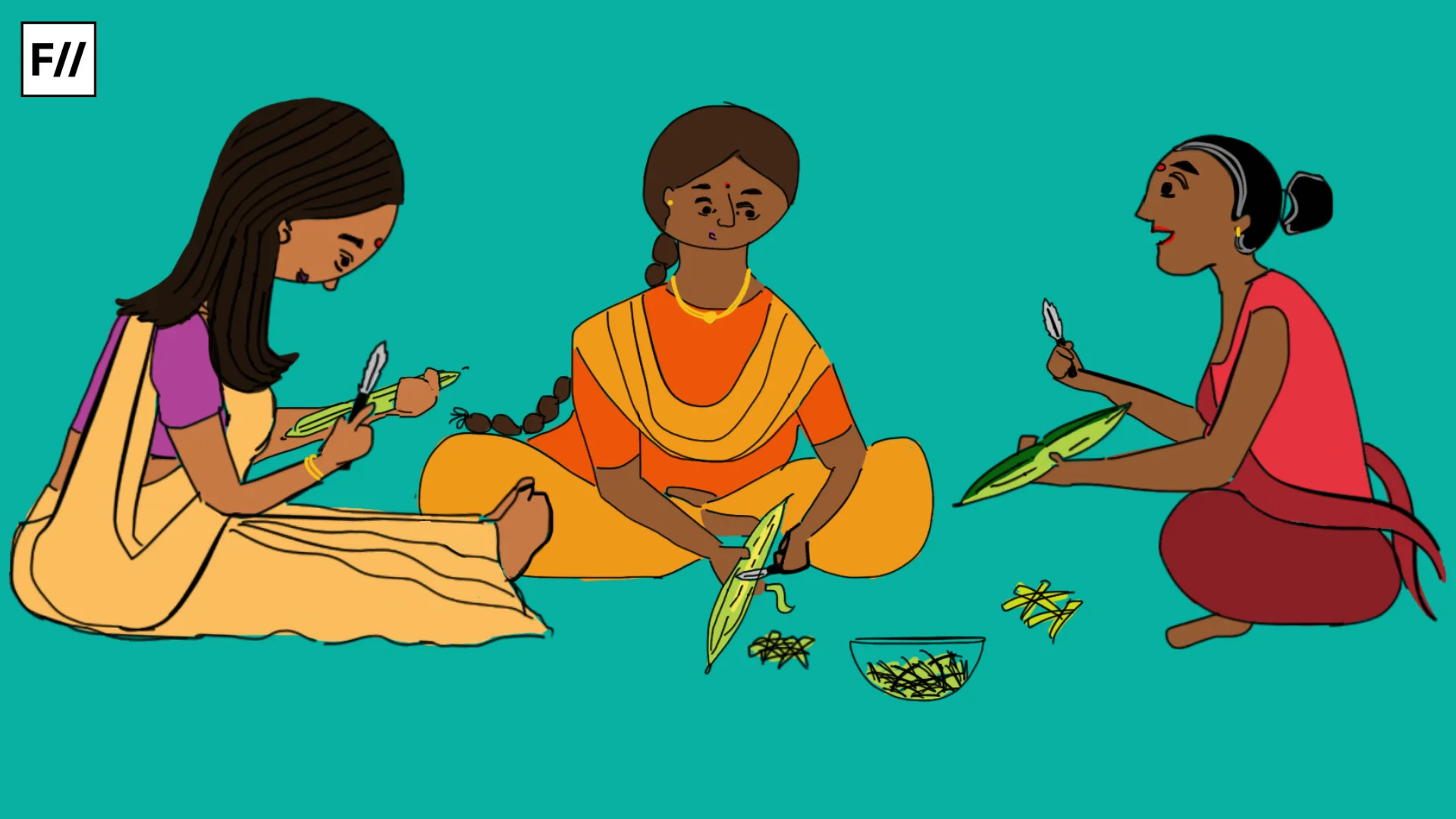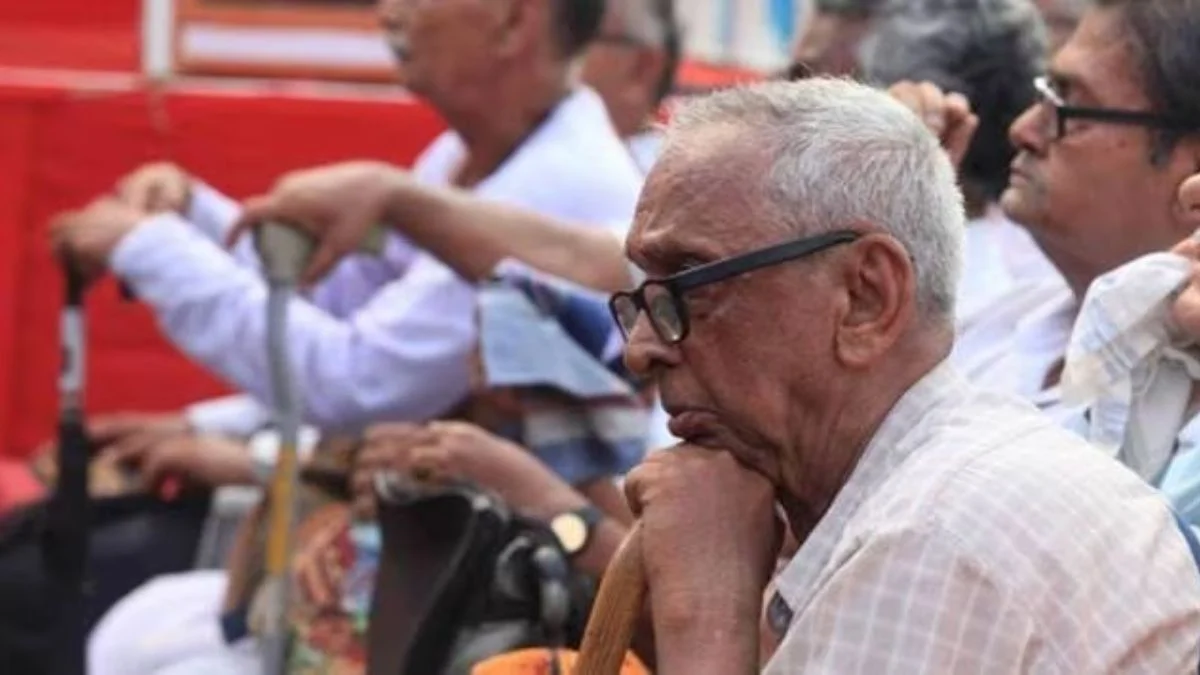जेंडर स्टीरियोटाइपिंग : लिंग आधारित पूर्वाग्रह कैसे पितृसत्ता को करते हैं मज़बूत

समाज में लिंग आधारित रूढ़िवादी सोच या असमानताएं एक दम से नहीं उपजती हैं बल्कि इन्हें बोया जाता है। हर इंसान के बचपन में ही माता-पिता, परिवार के अन्य सदस्य, स्कूल और समाज के द्वारा इन्हें बोया जाता है। इस तरह एक इंसान बचपन से व्यस्क होने तक के सफर तक रूढ़िवादी, पितृसत्तात्मक सोच और असामनताओं का भरा-पूरा पेड़ बन जाता है। यह बोया गया बीज है जेंडर स्टीरियोटाइपिंग या लिंग रूढ़िबद्धता, जो स्त्री-पुरुष के अंतर को कभी भरने नहीं देता। यह इनके काम, पसंद-नापसंद और व्यवहार को अलग-अलग परिभाषित करके रखता है। बचपन से ही इसकी ट्रेनिंग बच्चों को दी जाती है। जब तक जेंडर स्टीरियोटाइपिंग खत्म नहीं होगा तब तक समाज में जेंडर आधारित असामानताएं बनी रहेंगी।

जेंडर स्टीरियोटाइपिंग क्या है?
जेंडर स्टीरियोटाइपिंग किसी व्यक्ति के बारे में उसके लिंग के आधार पर बनाई गई धारणा है, जो समाज में उसकी विशेषताओं, व्यवहारों और जिम्मेदारियों को लिंग के अनुसार परिभाषित करती है। उदाहरण के तौर पर हमारा समाज महिलाओं को ऐसे व्यक्ति के रूप में देखता है जो परिवार और परिवार के सदस्यों की सेहत और खानपान का ध्यान रखें और पुरुष को परिवार के मुखिया और संरक्षक के तौर पर जाना जाता है। ये धारणाएं पूरी तरह पर लिंग आधारित हैं। ये काम निर्धारित करने में किसी इंसान की इच्छा, कौशलता, कार्य कुशलता, आदि मानक न होकर उनका व्यक्तिगत लिंग ही मानक होता है। जेंडर स्टीरियोटाइपिंग मौलिक स्वतंत्रताओं का उल्लंघन करता है। कैसे व्यवहार करें और कैसे न करें, इस पर पुरुषों और महिलाओं को समाज के दबाव का सामना करना पड़ता है। यह दवाब उनके लिए शारीरिक, मानसिक, सामाजिक और आर्थिक रूप से नुकसानदायक हैं और उनकी क्षमताओं को सीमित करता है।
और पढ़ें : लैंगिक समानता के बहाने क़ायम जेंडर रोल वाले विशेषाधिकार| नारीवादी चश्मा
महिलाओं और पुरुषों से पितृसत्तात्मक समाज की अपेक्षाएं
महिलाओं और पुरुषों से समाज द्वारा उनके लिंग के आधार पर की जाने वाली अपेक्षाएं बहुत अलग-अलग हैं। इसमें पुरुषों को महिलाओं पर अधिकार दिया जाता है और महिलाओं से उम्मीद की जाती है कि वे इसका पालन करें। पुरुषों से उम्मीद की जाती है कि महिलाओं की हर ज़रूरत की चीज़ वे ही उन्हें मुहैया कराए और बदले में महिलाएं उनकी और परिवार की देखभाल करेंगी। पैसे से संबंधित या परिवार से संबंधित सभी मुख्य फैसलों पर भी सिर्फ पुरुषों का ही अधिकार होता है। महिलाओं से अपेक्षा की जाती है कि वे अपने पिता या पति के द्वारा लिए गए निर्णयों का सम्मान करें और घर के बड़ों के सामने अपनी असहमति न ज़ाहिर करें, अपने अधिकार की बात न करें और ऊंची आवाज में न बोलें।
जेंडर स्टीरियोटाइपिंग किसी व्यक्ति के बारे में उसके लिंग के आधार पर बनाई गई धारणा है, जो समाज में उसकी विशेषताओं, व्यवहारों और जिम्मेदारियों को लिंग के अनुसार परिभाषित करती है।
पुरुषों को घर का करता-धरता माना जाता है, इसलिए उनकी शिक्षा को भी महत्त्व दिया जाता है। महिलाओं से सिर्फ चुल्हे-चौके और बच्चों की परवरिश की उम्मीद करता ये समाज उनकी शिक्षा को या तो कुछ कक्षाओं तक सीमित कर देता है या पूरी तरह नज़रअंदाज़ करता है। समाज की यह धारणाएं सिर्फ स्त्री-पुरुष व्यवहार को लेकर ही नहीं होती बल्कि उनकी शारीरिक विशेषताओं को भी परिभाषित करती हैं। महिलाओं के लिए पतला शरीर, गुलाबी होंठ, गौरा रंग, चमकदार बाल, ये सभी सुंदरता के मानक हैं। वहीं पुरुष जब लंबे कद और मजबूत शरीर के हो तो ही उन्हें आकर्षक माना जाता है। इन सुंदरता मानकों पर खरे न उतरने वाले स्त्री और पुरुष समाज के तानों और असंवेदनशीलता का शिकार होते हैं। महिलाएं सहनशील हो, शांत हो, उनका पहनावा, बातचीत का तरीका, बैठने का तरीका समाज के अनुसार मर्यादापूर्ण हो और उन्हें बेवजह या खुलकर सार्वजनिक रूप से नहीं हंसना चाहिए जबकि पुरुषों को आत्मविश्वासी समझा जाता है और उनके बोलने या हंसने पर ऐसा कोई दबाव नही होता है।
और पढ़ें : पितृसत्ता के बदले रंग के बीच महिलाओं के बुनियादी अधिकार
जेंडर स्टीरियोटाइपिंग से बढ़ती है हिंसा और मानसिक स्वास्थ्य जैसी समस्याएं
हमारा समाज पुरुषों को महिलाओं से कही अधिक ताकत और अधिकार देता है। समाज पुरुषों को सिखाता है कि महिलाओं पर उनका अधिकार है और महिलाएं हमेशा पुरुषों के अधीन होनी चाहिए। पुरुषों को मजबूत और आक्रामक होने की सीख देती पितृसत्तात्मक समाज की धारणाएं मैरिटल रेप जैसे यौन उत्पीड़न और महिलाओं के प्रति होने वाली घरेलू हिंसा को सामान्य बनाती हैं। हमारा समाज महिलाओं को पुरुषों की तुलना में कम आंकता है, उनकी क्षमता पर सवाल खड़ा किया जाता है। मौजूद संसाधनों पर महिलाओं का पुरुषों के अनुरूप कम अधिकार होता है, महिलाओं के अधिकारों का सम्मान और समर्थन नहीं किया जाता। इन सब के परिणामस्वरूप महिलाओं के प्रति शारीरिक हिंसा और मानसिक स्वास्थ्य के मुद्दों में वृद्धि होती है।
हालांकि, समाज में पुरुष अधिक ताकत और अधिकार रखता है लेकिन पुरुषों से समाज की जो उम्मीदें और धारणाएं है वे उनके लिए अत्यधिक दवाब का कारण बनती हैं। उन्हें अपनी शिक्षा और अच्छे भविष्य को लेकर मानसिक दबाव सहना पड़ता है। पुरुषों पर एक अच्छी कमाऊ नौकरी करने का दबाव हर वक्त रहता है क्योंकि समाज की नजरों में आदर्श पुरुष वही है जो परिवार को आर्थिक तंगी न होने दे। परिवार की आर्थिक ज़रूरतों को पूरा न कर पाने वाले पुरुष को समाज एक अच्छा पिता, पति और भाई नहीं मानता है। ये दवाब वे अक्सर किसी से साझा भी नहीं करते। उन पर हर वक्त मजबूत दिखने और खुद की भावनाओं और संवेदनाओं को दबाकर रखने का दवाब होता है क्योंकि उन्हें परिवार का संरक्षक माना जाता है, इसलिए वे कमजोर अथवा भावुक नही हो सकते हैं।
जागरूकता और जेंडर न्यूट्रल शिक्षा की आवश्यकता
जेंडर स्टीरियोटाइपिंग की शिक्षा हमें बचपन से दी जाती है। जब एक बच्चा अपनी माँ को सिर्फ घर का काम और पिता को बाहर काम करते देखकर बड़ा होता है, तो यही सीखता भी है। वह सीखता है कि रोटियां बनाना केवल माँ का काम है और आटा खरीदने के लिए पैसे कमाना पिता का काम है। जब बेटी को खिलौने में गुड़िया और किचन सेट दिया जाता है और बेटे को गाड़ी या कोई काल्पनिक सुपर हीरो, तब हम उन्हें यह सीखने पर मजबूर करते हैं कि खिलौने भी लिंग के आधार पर पसंद करने चाहिए।
हमारी सोसाइटी, फिल्में, सीरियल, विज्ञापन आदि हमें व्यवस्थित तरीके से लिंग रुढ़िवादी सोच परोसते हैं। विज्ञापन महिलाओं की शारीरिक सुंदरता का मानक दर्शाते हैं, सीरियल महिलाओं को आदर्श महिला होने का पाठ पढ़ाते हैं और फिल्में नायक को महिलाओं का संरक्षक दर्शाती हैं। ना चाहते हुए भी खुद को समाज की इन धारणाओं से बचाना मुशकिल प्रतीत होता है। यह सोच हमारी सोच-समझ को प्रभावित करती है। साथ ही जेंडर को सिर्फ स्त्री और पुरुष तक सीमित रखती है। इसमें ट्रांस, नॉन बाइनरी, एलजीबीटी+ समुदाय को अलग रखा जाता है। इसलिए समाज में इसके प्रति जागरूकता और जेंडर न्यूट्रल शिक्षा की ज़रूरत है, ताकि स्त्री-पुरुष की बीच असमानताओं के इस अनुमानित अंतर को खत्म किया जा सके।
और पढ़ें : पितृसत्ता में लड़कियों की ट्रेनिंग नहीं कंडिशनिंग होती है| नारीवादी चश्मा
तस्वीर : रितिका बनर्जी फेमिनिज़म इन इंडिया के लिए

I am Monika Pundir, a student of journalism. A feminist, poet and a social activist who is giving her best for an inclusive world.
Leave a Reply Cancel reply
संबंधित लेख.

पत्नी का पत्रः ‘संस्कारी’ होने के नियमों से आगे निकल खुद के लिए राह चुनती एक स्त्री की कहानी
By Sarala Asthana

76 फीसद अवैतनिक स्वास्थ्य देखभाल गतिविधियां महिलाएं कर रही हैं: डब्ल्यूएचओ रिपोर्ट
By Masoom Qamar

महिलाओं के खिलाफ हिंसा और मनोरंजन की दुनिया की भूमिका
By Malabika Dhar

जल्दी करें, सीमित स्टॉक उपलब्ध!!
- Study Material

Gender Equality Essay in Hindi – लिंग समानता पर निबंध
Gender Equality Essay in Hindi: समानता या गैर-भेदभाव वह राज्य है जहां हर व्यक्ति को समान अवसर और अधिकार मिलते हैं। समाज का प्रत्येक व्यक्ति समान स्थिति, अवसर और अधिकारों के लिए तरसता है। हालांकि, यह एक सामान्य अवलोकन है कि मनुष्यों के बीच बहुत भेदभाव मौजूद है। सांस्कृतिक अंतर, भौगोलिक अंतर और लिंग के कारण भेदभाव मौजूद है। लिंग पर आधारित असमानता एक ऐसी चिंता है जो पूरी दुनिया में प्रचलित है। 21 वीं सदी में भी, दुनिया भर में पुरुष और महिलाएं समान विशेषाधिकार प्राप्त नहीं करते हैं। लैंगिक समानता का अर्थ राजनीतिक, आर्थिक, शिक्षा और स्वास्थ्य पहलुओं में पुरुषों और महिलाओं दोनों को समान अवसर प्रदान करना है।
Gender Equality Essay in Hindi – लिंग समानता पर निबंध

लिंग समानता का महत्व
एक राष्ट्र प्रगति कर सकता है और उच्च विकास दर तभी प्राप्त कर सकता है जब पुरुष और महिला दोनों समान अवसरों के हकदार हों। समाज में महिलाओं को अक्सर मक्का में रखा जाता है और उन्हें मजदूरी के मामले में स्वास्थ्य, शिक्षा, निर्णय लेने और आर्थिक स्वतंत्रता के लिए पुरुषों के समान अधिकार प्राप्त करने से परहेज किया जाता है।
सामाजिक संरचना जो लंबे समय से इस तरह से प्रचलित है कि लड़कियों को पुरुषों के समान अवसर नहीं मिलते हैं। महिलाएं आमतौर पर परिवार में देखभाल करने वाली होती हैं। इस वजह से, महिलाएं ज्यादातर घरेलू गतिविधियों में शामिल होती हैं। उच्च शिक्षा, निर्णय लेने की भूमिका और नेतृत्वकारी भूमिकाओं में महिलाओं की कम भागीदारी है। यह लैंगिक असमानता किसी देश की विकास दर में बाधा है। जब महिलाएं कार्यबल में भाग लेती हैं तो देश की आर्थिक विकास दर बढ़ जाती है। लैंगिक समानता आर्थिक समृद्धि के साथ-साथ राष्ट्र की समग्र भलाई को बढ़ाती है।

लिंग समानता कैसे मापी जाती है?
देश के समग्र विकास को निर्धारित करने में लैंगिक समानता एक महत्वपूर्ण कारक है। लैंगिक समानता को मापने के लिए कई सूचकांक हैं।
Gender-Related Development Index (GDI) – GDI मानव विकास सूचकांक का एक लिंग केंद्रित उपाय है। जीडीआई किसी देश की लैंगिक समानता का आकलन करने में जीवन प्रत्याशा, शिक्षा और आय जैसे मापदंडों पर विचार करता है।
लिंग सशक्तीकरण उपाय (GEM) – इस उपाय में बहुत अधिक विस्तृत पहलू शामिल हैं जैसे राष्ट्रीय संसद में महिला उम्मीदवारों की तुलना में सीटों का अनुपात, आर्थिक निर्णय लेने वाली भूमिका में महिलाओं का प्रतिशत, महिला कर्मचारियों की आय का हिस्सा।
Gender Equity Index (GEI) – GEI लैंगिक असमानता के तीन मानकों पर देशों को रैंक करता है, वे हैं शिक्षा, आर्थिक भागीदारी और सशक्तिकरण। हालांकि, GEI स्वास्थ्य पैरामीटर की उपेक्षा करता है।
ग्लोबल जेंडर गैप इंडेक्स – वर्ल्ड इकोनॉमिक फोरम ने 2006 में ग्लोबल जेंडर गैप इंडेक्स की शुरुआत की थी। यह इंडेक्स महिला नुकसान के स्तर की पहचान करने पर अधिक ध्यान केंद्रित करता है। सूचकांक जिन चार महत्वपूर्ण क्षेत्रों पर विचार करता है वे हैं आर्थिक भागीदारी और अवसर, शैक्षिक प्राप्ति, राजनीतिक सशक्तीकरण, स्वास्थ्य और उत्तरजीविता दर।
भारत में लिंग असमानता
विश्व आर्थिक मंच की लैंगिक अंतर रैंकिंग के अनुसार, भारत 149 देशों में से 108 वें स्थान पर है। यह रैंक एक प्रमुख चिंता का विषय है क्योंकि यह पुरुषों की तुलना में महिलाओं में अवसरों के भारी अंतर को उजागर करता है। भारतीय समाज में लंबे समय से, सामाजिक संरचना ऐसी रही है कि शिक्षा, स्वास्थ्य, निर्णय लेने के क्षेत्रों, वित्तीय स्वतंत्रता आदि जैसे कई क्षेत्रों में महिलाओं की उपेक्षा की जाती है।
एक और प्रमुख कारण, जो भारत में महिलाओं के प्रति भेदभावपूर्ण व्यवहार में योगदान देता है, वह है विवाह में दहेज प्रथा। इस दहेज प्रथा के कारण ज्यादातर भारतीय परिवार लड़कियों को बोझ समझते हैं। बेटे के लिए पसंद अभी भी कायम है। लड़कियों ने उच्च शिक्षा से परहेज किया है। महिलाएं समान रोजगार के अवसरों और मजदूरी की हकदार नहीं हैं। 21 वीं सदी में, महिलाओं को अभी भी घर के प्रबंधन गतिविधियों में लिंग पसंद किया जाता है। कई महिलाओं ने परिवार की प्रतिबद्धताओं के कारण अपनी नौकरी छोड़ दी और नेतृत्व की भूमिकाओं से बाहर हो गईं। हालांकि, पुरुषों के बीच ऐसी क्रियाएं बहुत ही असामान्य हैं।
500+ Essays in Hindi – सभी विषय पर 500 से अधिक निबंध
एक राष्ट्र की समग्र भलाई और विकास के लिए, लैंगिक समानता पर उच्च स्कोर करना सबसे महत्वपूर्ण पहलू है। लैंगिक समानता में कम असमानता वाले देशों ने बहुत प्रगति की है। लैंगिक समानता सुनिश्चित करने के लिए भारत सरकार ने भी कदम उठाने शुरू कर दिए हैं। लड़कियों को प्रोत्साहित करने के लिए कई कानून और नीतियां तैयार की जाती हैं। “बेटी बचाओ, बेटी पढाओ योजना ” (लड़की बचाओ, और लड़कियों को शिक्षित बनाओ) अभियान बालिकाओं के महत्व के बारे में जागरूकता फैलाने के लिए बनाया गया है। लड़कियों की सुरक्षा के लिए कई कानून भी हैं। हालाँकि, हमें महिला अधिकारों के बारे में ज्ञान फैलाने के लिए अधिक जागरूकता की आवश्यकता है। इसके अलावा, सरकार को नीतियों के सही और उचित कार्यान्वयन की जांच करने के लिए पहल करनी चाहिए।
RELATED ARTICLES MORE FROM AUTHOR

How to Write an AP English Essay

इंडिया गेट पर निबंध – Essay on India Gate in Hindi

जनसंख्या वृद्धि पर निबंध – Essay on Population Growth in Hindi
Leave a reply cancel reply.
Save my name, email, and website in this browser for the next time I comment.
Essays - निबंध
10 lines on diwali in hindi – दिवाली पर 10 लाइनें पंक्तियाँ, essay on my school in english, essay on women empowerment in english, essay on mahatma gandhi in english, essay on pollution in english.
- Privacy Policy
Academia.edu no longer supports Internet Explorer.
To browse Academia.edu and the wider internet faster and more securely, please take a few seconds to upgrade your browser .
Enter the email address you signed up with and we'll email you a reset link.
- We're Hiring!
- Help Center

Undoing Gender Stereotypes in Hindi

2004, Linguistik online
Related Papers
Vandana Pathak
Advertising hoardings are common in cities. Hoardings are put up at almost all squares and near all bus stops/stations/railway stations/airports, malls, multiplexes, etc. Thus, these hoardings are omnipresent. These hoardings attract public attention because of their textual message and visuals. The language employed in these hoardings is simple and shows an economy in the use of words. The main function is to convey the message about a product or service in an effective manner. This linguistic communication or advertisement discourse can be studied from various points of view. This paper is a humble effort to study advertising hoardings in Nagpur city from the point of view of Sociolinguistics.
Mrinalini Ray
This research explores the lived realities of transgenders who enter the Hijra community and the various forms of social exclusion that these individuals face and the ways in which they respond, thereby shaping their identity. It focuses on the lives of the transgenders that helps construct their identity as a 'hijra'. The symbolic interactionist perspective and labelling theory are used as theoretical anchors. Some of the main forms of exclusion that the respondents spoke of are familial ostracisation, physical and verbal abuse, forced sex, extortion of money and materials by the police and arrests on false allegations; restricted access to education, health services and public spaces and a severe curtailment of livelihood options. One of the significant coping mechanisms is the process of becoming members of a hijra community and enrolling in a 'guruchela' relationship. In exploring the nuances of this turn and the experience of exclusion, the study contributes to a discussion on the implementation of affirmative action of the state.
Jessica Chandras
Penelope H Gardner-Chloros
It is argued in this paper that CS should be considered first and foremost from a sociolinguistic perspective, that is to say from a perspective where lan- guage behavior and use are related to speakers’ (social) identity and characteristics, or to aspects of their social life in the broad sense.
Mian Md. Naushaad Kabir
English is one of the most used languages in the world. In Bangladesh, English is introduced here at the primary level and its inclusion continues till the tertiary level of education. A student has to study English as a compulsory subject for ten years to pass the S.S.C. exam. At the secondary level in Bangladesh, English is taught for five years followed by the curriculum of the primary level that includes the learning of English for five years as well. However, after ten years' schooling of English, most of the students fail in English in the S.S.C. exam. Even if they pass, they get very poor marks. However, the students who pass and somehow get good marks do not seem to reflect their achievement practically. They can neither speak fluently and naturally nor understand English when they are not spoken to nor comprehend the meaning of what they read nor can they interpret the reading materials. They cannot write correctly and speak out their feelings and opinions. As a result, they do not learn English at all and reach the target stage that they were supposed to by the end of their curriculum. They pass the examination but actually they are unable to use the language. An empirical study of the causes of the secondary students’ failure in learning English is done. Schools are visited, and data are collected through questionnaire surveys and interviews of the teachers, students and guardians; data are analysed, and finally presented to reveal the causes of their failure.
UC Berkeley Department of Linguistics
My unpublished UC Berkeley PhD dissertation on the language practices of Hindi-speaking hijras in northern India. Dissertation committee: Robin Lakoff, Leanne Hinton, Linda Hess, Nancy Chodorow, and Penny Eckert.
This dissertation is based on a long-term ethnographic and sociophonetic study of 15 transgender people on the female-to-male (or transmasculine) identity spectrum. The focus of the study is the way these individuals’ voices change during the first 1-2 years of masculinizing hormone therapy, which brings about a drop in vocal pitch along with other salient physiological changes. Based on regular recordings of participants during a one year period, the analysis tracks changes in fundamental frequency as well as formant frequencies and the acoustic characteristics of [s], each of which has a different place in biology-driven theories of gender and the voice. In addition to ostensibly hormonally driven changes to speakers’ available fundamental frequency range, I present evidence that these speakers are engaged in various types of articulatory shifts as part of their gender role transition, which affect both formants and [s]. However, I argue that changes in all three of the phonetic domains examined here must be situated in both sociocultural and linguistic context, even where biology appears to play a significant role. The analyses presented, which include attention to both intra- and inter-speaker variation, draw on a multi-layered understanding of gender derived from transgender people’s own distinctions between gender assignment, gender role, gender identity, and gender presentation. My speakers’ metalinguistic commentary on gender and the voice further elucidates the constellations of phonetic features that combine to create their cohesive gendered speaking styles. Ultimately, I focus on the ways that changes in one phonetic variable, like pitch, can recontextualize other elements of a speaker’s linguistic style, like the acoustic spectrum of [s]. This connection drives home the necessity of considering the relationship between linguistic characteristics, rather than treating them as entirely separable variables. Attention to stylistic wholes, over individual variables, points us toward the notion that transmasculine individuals do not engage in across-the-board masculinization, but rather bring together acoustic characteristics acquired from disparate sources in order to construct phonetic styles that reflect their complex affiliations with manhood, maleness, and masculinity.
Ali R Fatihi
Language Vitality in South Asia is the selected proceeding of the the 8th International conference of South Asian Languages (ICOSAL). ICOSAL-8 was held on January 8, 2008 at the Aligarh Muslim University Aligarh, with generous sponsorship from the CIIL Mysore, and the Department of Linguistics AMU Aligarh. We would like to acknowledge the material and intellectual support from these units, as well as the assistance of several students, faculty, and staff members at AMU, who contributed to the success of ICOSAL 8, including Prof U N Singh. Prof ON Koul, Prof Khoklova, Prof Zakharyan, Prof Annie Montaut, Prof Subbarao, Prof Shreesh Chaudhry and Prof Anjani K Sinha. The two and a half day conference, whose theme was ‘ South Asian Languages in Context’, featured six invited plenary presentations.
Ellen Bramwell
Personal names are a human universal, but systems of naming vary across cultures. While a person’s name identifies them immediately with a particular cultural background, this aspect of identity is rarely researched in a systematic way. This thesis examines naming patterns as a product of the society in which they are used. Personal names have been studied within separate disciplines, but to date there has been little intersection between them. This study marries approaches from anthropology and linguistic research to provide a more comprehensive approach to name-study. Specifically, this is a cross-cultural study of the naming practices of several diverse communities in Scotland, United Kingdom. The purpose of the project is to compare and contrast the personal naming systems of a range of indigenous and immigrant communities whose social and linguistic contexts vary extensively. In doing so, it investigates links between personal names, social change, cultural contact and linguistic systems, and hopes to contribute towards examining universal features of naming systems and developing a theory of names.
RELATED PAPERS
Lawal Lukman Ademola
Journal of Pragmatics
Rachel Giora
Radek Skarnitzl
Dr. GEORGE KOLANCHERY
Nurul Ain Mohd Hasan
Dr. RUZBEH BABAEE
Susanna Varma
Dariush Saberi
International Journal of Research and Analytical Reviews
Dr. Toyeba Mushtaq
In Alessandro Duranti (ed.), A Companion to Linguistic Anthropology
Shamala Paramasivam
Tariq Khan , Bindu Byrapuneni
Texas Linguistic Forum
Hannah Carlan
A companion to linguistic anthropology
Journal of The Acoustical Society of America
Tracy Morison
JEELS (Journal of English Education and Linguistics Studies)
Sidrah Bashir
Cecy Hurtado
metaphorik.de
Suneeta Mishra
Rashmi Jacob
Archives of Sexual Behavior
Jared McKenzie
Hanna Pulaczewska
Angeliki Alvanoudi
Linguistik Online Vol. 68, No 6
Marcin Lewandowski
The Routledge companion to sociolinguistics
Barbara Fennell
Ahmad Mardini
Madhurima Guha
Kinh Tế Học
Language in Society
sharita BHARUTHRAM
Gender and Language
Christina Schoux Casey
Alex Gilmore
Umul Baneen
RELATED TOPICS
- We're Hiring!
- Help Center
- Find new research papers in:
- Health Sciences
- Earth Sciences
- Cognitive Science
- Mathematics
- Computer Science
- Academia ©2024

COMMENTS
समाज में लिंग आधारित रूढ़िवादी सोच या असमानताएं एक दम से नहीं उपजती हैं बल्कि इन्हें बोया जाता है। हर इंसान के बचपन में ही माता-पिता, परिवार के अन्य ...
Gender Equality Essay in Hindi: समानता या गैर-भेदभाव वह राज्य है जहां हर व्यक्ति को समान अवसर और अधिकार मिलते हैं। समाज का प्रत्येक व्यक्ति समान स्थिति, अवसर और अधिकारों ...
निष्कर्ष | Conclusion. हर समस्या का समाधान होता है, इसलिए उचित समाधान के जरिए भारत में लैंगिक असमानता (Gender Inequality In India in Hindi) को भी दूर किया जा सकता है ...
View PDF. Undoing Gender Stereotypes in Hindi* Anjali Pande (New Delhi) Abstract The basic prerequisite for using any language is the willingness of the speaker to follow the rules of the game. Socially defined norms of language use then tend to set the limits within which one can express oneself using this language.